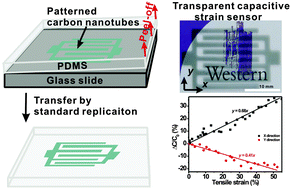Although the constant miniaturisation of consumer electronics has made it perfectly normal for somebody to leave their home in the morning carrying more screens than they leave behind, modern devices are still limited to being as physically rigid as spinning wheels and seed drills. The usefulness of flexible displays, wearable electronics and tactile sensors would all be improved dramatically by the development of reliable non-rigid conductors.
Wang et al. have recently devised a methodology for the manufacture of a stretchable material composed of highly conductive single-walled carbon nanotubes (SWCNTs) and a polydimethylsiloxane (PDMS) elastomer. The procedure starts with the preparation of a “non-stick” substrate obtained by perfluorinating glass. A suspension of SWCNTs in chloroform is then airbrushed over the substrate followed by the application of uncured PDMS. Following curing, an elastomer film with embedded nanotubes is obtained. An experiment examining the change in resistance with respect to tensile strain revealed that although resistance increased with strain when first stretched (as is generally observed), when the strain was removed and for the next ninety-nine strain-release cycles the resistance consistently decreased with increasing strain. This suggests that the first strain serves to orient the nanotubes in a particular way leading to this unexpected behaviour. In addition, the researchers found that specific patterns could be obtained by using patterned substrates or by simply spraying the SWCNT suspension through a patterned mask. The latter allowed the fabrication of a proof-of-concept strain sensor, touch pad and pressure sensor. All three devices were effective and demonstrate the utility of the fabrication technique.
Transparent, stretchable, carbon-nanotube-inlaid conductors enabled by standard replication technology for capacitive pressure, strain and touch sensors
Xiaolong Wang, Tingjie Le, Jillian Adams and Jun Yang
J. Mater. Chem. A, 2013, 1, 3580. DOI:10.1039/C3TA00079f
James Serginson is a guest web writer for the Journal of Materials Chemistry blog. He currently works at Imperial College London carrying out research into nanocomposites.
To keep up-to-date with all the latest research, sign-up to our RSS feed or Table of contents alert.











